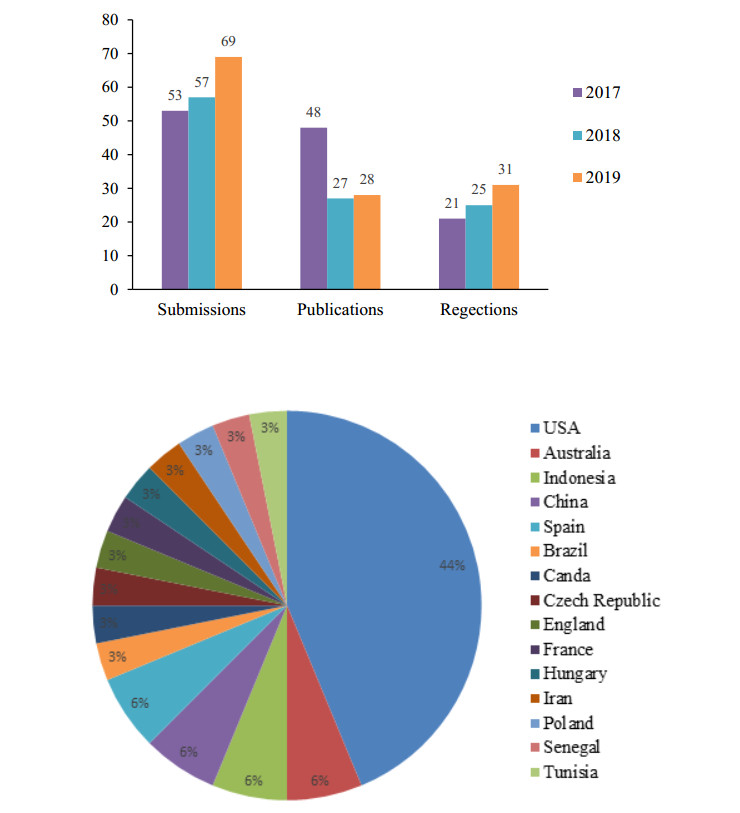The morphology of solid tumours is known to be affected by the background oxygen concentration of the tissue in which the tumour grows, and both computational and experimental studies have suggested that branched tumour morphology in low oxygen concentration is caused by diffusion-limited growth. In this paper we present a simple hybrid cellular automaton model of solid tumour growth aimed at investigating this phenomenon. Simulation results show that for high consumption rates (or equivalently low oxygen concentrations) the tumours exhibit branched morphologies, but more importantly the simplicity of the model allows for an analytic approach to the problem. By applying a steady-state assumption we derive an approximate solution of the oxygen equation, which closely matches the simulation results. Further, we derive a dispersion relation which reveals that the average branch width in the tumour depends on the width of the active rim, and that a smaller active rim gives rise to thinner branches. Comparison between the prediction of the stability analysis and the results from the simulations shows good agreement between theory and simulation.
Citation: Philip Gerlee, Alexander R. A. Anderson. Diffusion-limited tumour growth: Simulations and analysis[J]. Mathematical Biosciences and Engineering, 2010, 7(2): 385-400. doi: 10.3934/mbe.2010.7.385
Related Papers:
| [1] |
Yifeng Wang .
Journal summary from Editor in Chief. AIMS Environmental Science, 2024, 11(3): 380-380.
doi: 10.3934/environsci.2024018
|
| [2] |
Yifeng Wang .
Journal summary from Editor in Chief. AIMS Environmental Science, 2025, 12(2): 252-252.
doi: 10.3934/environsci.2025011
|
| [3] |
Yifeng Wang .
Journal summary from Editor in Chief. AIMS Environmental Science, 2021, 8(2): 100-100.
doi: 10.3934/environsci.2021007
|
| [4] |
Yifeng Wang .
Journal summary from Editor in Chief. AIMS Environmental Science, 2022, 9(2): 217-217.
doi: 10.3934/environsci.2022014
|
| [5] |
Yifeng Wang .
Journal summary from Editor in Chief. AIMS Environmental Science, 2023, 10(2): 245-245.
doi: 10.3934/environsci.2023014
|
| [6] |
Yifeng Wang .
Journal summary from Editor in Chief. AIMS Environmental Science, 2018, 5(1): 64-66.
doi: 10.3934/environsci.2018.1.64
|
| [7] |
Yifeng Wang .
Journal summary from Editor in Chief. AIMS Environmental Science, 2016, 3(1): 140-140.
doi: 10.3934/environsci.2016.1.140
|
| [8] |
Yifeng Wang .
Journal summary from Editor in Chief. AIMS Environmental Science, 2019, 6(4): 262-264.
doi: 10.3934/environsci.2019.4.262
|
| [9] |
Yifeng Wang .
Journal summary from Editor in Chief. AIMS Environmental Science, 2017, 4(2): 287-288.
doi: 10.3934/environsci.2017.2.287
|
| [10] |
Rukhsana Kokkadan, Resha Neznin, Praseeja Cheruparambath, Jerisa Cabilao, Salma Albouchi .
A Study of Infaunal Abundance, Diversity and Distribution in Chettuva Mangrove, Kerala, India. AIMS Environmental Science, 2023, 10(1): 82-92.
doi: 10.3934/environsci.2023005
|
Abstract
The morphology of solid tumours is known to be affected by the background oxygen concentration of the tissue in which the tumour grows, and both computational and experimental studies have suggested that branched tumour morphology in low oxygen concentration is caused by diffusion-limited growth. In this paper we present a simple hybrid cellular automaton model of solid tumour growth aimed at investigating this phenomenon. Simulation results show that for high consumption rates (or equivalently low oxygen concentrations) the tumours exhibit branched morphologies, but more importantly the simplicity of the model allows for an analytic approach to the problem. By applying a steady-state assumption we derive an approximate solution of the oxygen equation, which closely matches the simulation results. Further, we derive a dispersion relation which reveals that the average branch width in the tumour depends on the width of the active rim, and that a smaller active rim gives rise to thinner branches. Comparison between the prediction of the stability analysis and the results from the simulations shows good agreement between theory and simulation.
Dear Editorial Board Members,
It is my pleasure to share with you the year-end report for AIMS Environmental Science. The journal continues to improve its quality as indicated by steady increases in the number of manuscripts received and the number of articles published over the past three years (Figure 1). We have received 69 submissions with 28 published online. The most downloaded and cited papers are listed in Tables 1 and 2. The top read article received more than 11390 downloads.
I would like to thank all the board members for serving on the Editorial Board and their dedication and contribution to the journal, especially to the editors for two special issues: Impacts of Microplastics in the Urban Environment Conference and Green built environment. The goal in 2020 is to solicit more manuscripts and increase paper citations. We will try our best to reduce the processing time and supply with a better experience for publication. To recognize the contribution of the Editorial Board members and authors during the years, we will continue to offer that (1) for authors invited, the article processing charge (APC) is automatically waived; (2) each editorial board member is entitled for some waivers. I am looking forward to continuing working with you to make the AIMS Environmental Science a sustainable and impactful journal. Please don’t hesitate to send me e-mails if you have new ideas and suggestions to help us to achieve this goal.

Yifeng Wang, Ph.D.
Editor in Chief, AIMS Environmental Science










 DownLoad:
DownLoad:



